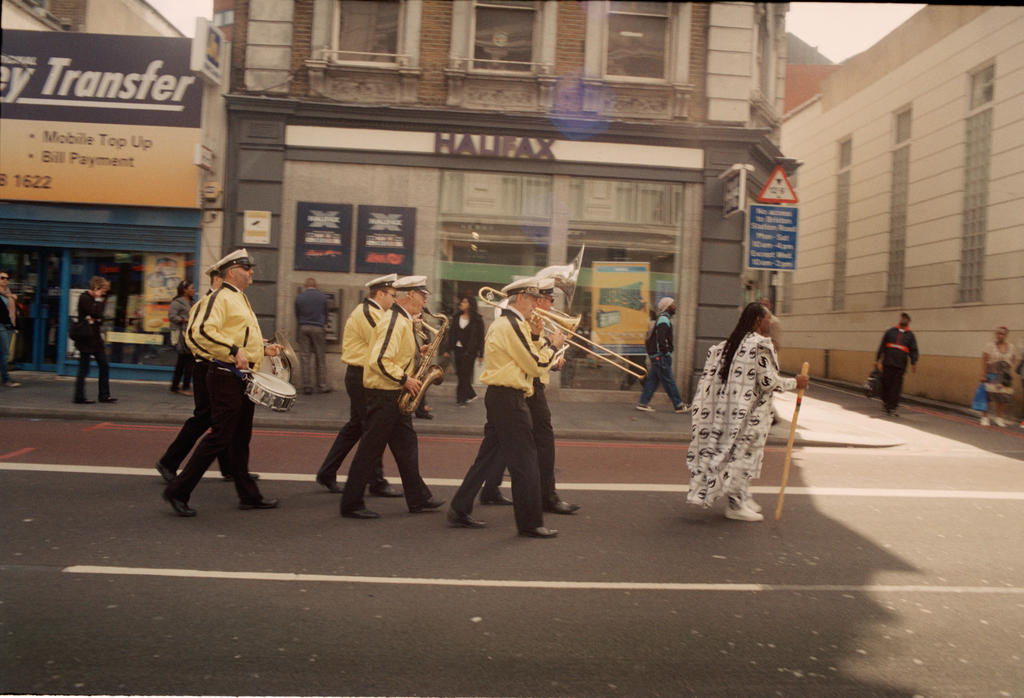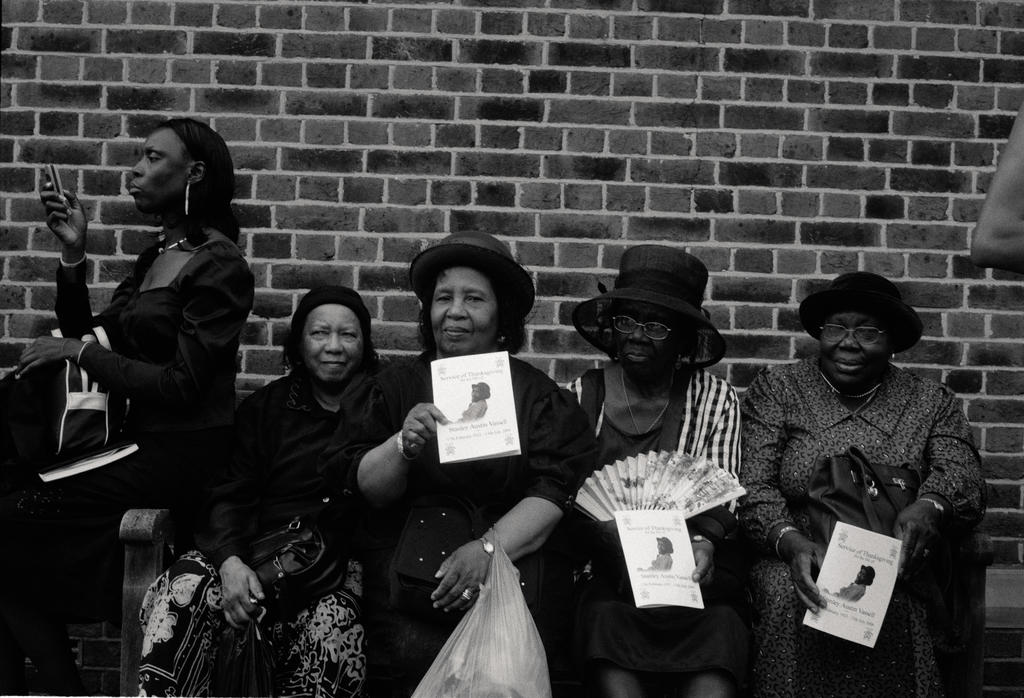
How Great Thou Art
†
Charlie Phillips –
the ‘Dead Man’s photographer’

Ronald ‘Charlie’ Phillips is a Jamaican-born restaurateur, photographer, and documenter of black London. His photographs have been published in magazines like Harper’s Bazaar, Life, Vogue, and Stern and he has exhibited his work in places like Tate Britain, the Museum of London, the Victoria & Albert Museum and MOCA Detroit. For his latest project, ‘How Great Thou Art’, a book documenting 50 years of African Caribbean funerals in London, the 70-year old teamed up with long-time Lodown contributor Eddie Otchere, who helped him to raise the necessary funds on ‘Kickstarter’ to be able to publish the book. Working through an archive of more than 5000 pictures, spanning 50 years, this book really is a representation of a lifetime’s work by Charlie - or as Eddie puts it: “This really is a people’s project, a declaration of love and celebration for the traditions and cultures of the Afro-Caribbean diaspora in London.” Reason enough for us to catch up with the man himself to find out all about ‘How Great Thou Art’.
So Charlie, how did you become a photographer?
I wasn’t meant to be a photographer. I’m self-taught and what I really wanted to be was a naval architect or an opera singer, but my parents came from a working class background and I wasn’t encouraged to do those jobs. During that time in the late 50s we used to have a lot of Americans here. The black American GIs used to come to Notting Hill Gate and Ladbroke Grove when it was a ghetto and they used to bring their music and there were all these house parties. This one GI one day left me a magazine called the ‘Saturday Evening Post’ and he also left a camera because he didn’t have enough fare to get back to his airbase and he pawned the camera to my dad. That’s when I started fiddling around with the camera and I went to the library and bought different books on how to take photographs. It was the era where the average family lived in one room, so while my parents were asleep I used to convert the toilet into a DIY darkroom. I always remember, it was a Kodak Retina camera and in those days you could buy a box that prints just a postcard size and you could do contact prints. I used to sell these photographs to my friends for fun and that’s how it started.”
Did you work as a photographer all your life?
No, after I left school in the 60s I did various jobs but I always used to take photographs on the side, mainly of my community. Then I went abroad and became more politically involved in the student riots. That’s when I documented a lot of ‘urban images’. I was also based in Italy for many years, where I was a paparazzi, especially during the ‘Dolce Vita’ era. In those days being a black photographer in England was very difficult because nobody would buy your work, so an Italian agent took me up and started selling my work. It’s not until about 10, 15 years ago that people in England knew who I was, yet they have seen my images all over the world for years. I have also done work for a lot of magazines and in those days I wasn’t too worried about getting credits. I just wanted to put bread on the table. In that time I used to go backwards and forwards from Italy to London and every time I came back I used to take pictures of my communities, this was from the 60s into the 2000s. I then had an exhibition in Italy and brought it back to England, but nobody wanted it and I couldn’t get any assignments, so I opened up a restaurant called ‘Smokey Joe’s Diner’.
What happened to all these pictures you had taken over the years?
I left my photographs all over the place and around ten years ago they wanted something ‘black’ to put on because this is when they started ‘Black History Month’ so we dug out all these photographs. Now, I was finally being accepted as part of London history, but it’s been suppressed over the years.
Why did you start taking pictures of Afro-Caribbean funerals (which is the topic of the ‘How Great Thou Art’ book you are doing together with Eddie Otchere)?
I have always had an interest in funerals because funerals in our community are not just about celebrating death, they are also about celebrating the life of the person being buried. A lot of our funerals go on for three days and they are big events. I started documenting funerals in 1962 and come to 2008 I found out how Caribbean funerals have been changing because one of the traditions was to sing spiritual songs and one of the main songs was ‘How Great Thou Art’, which is also the title of the book. Now we are going into the fifth generation of Afro-Caribbeans in England and over the years also with my photographs you realise how it has changed a lot because amongst the fifth generation the most popular songs they want to hear now are Frank Sinatra’s ‘I’ve Done It My Way’, Tina Turner’s ‘Simply The Best’ and Luther Vandross’ ‘Song For My Father’. This generation has lost a lot of the traditions that we used to have.
How did that happen?
Well, some of the traditions and some of the culture was brought over from Africa into this diaspora and some of it was mixed with religion as well. This generation just doesn’t seem to care about it anymore and I think it’s mainly because they are losing those values and that’s how they demolish our culture and traditions. I know we’re living in a modern society now but I do think it’s something we should stick to.
Were there any funerals you attended that stood out to you, that hold special memories?
There are two types of funerals, the traditional ones and the modern ones and this is what the book is also about, to show the difference between them. If it’s a senior citizen who died, they still keep the old traditions. If it’s a young person, who died, the celebrations last half the time and it sometimes becomes like a disco party. I mean even I admire Frank Sinatra, and he’s definitely done it his way, but let’s keep some of the old traditions. I also feel that the spiritual side is lacking now, you know. Alright, you don’t want the priest to go on all day, but a funeral is also supposed to celebrate someone’s life. Amongst a lot of the senior citizens, it’s one of the only social events they have these days, especially if you don’t want to get stuck playing Bingo or spending your time in a ‘Luncheon’ club. At a funeral you can see the fashion, the style, the music, the art, and the colours of the day. People request the guests to come in different colours and all this is dying out. Nowadays you see the younger generations turning up in jeans and I feel that they don’t respect the dead anymore.
Who is to blame for that?
I don’t think it’s their fault because living and growing up in England I think between the 70s and the 80s there has been a missing gap, and the 80s generation didn’t pass things on to the 90s and 2000s, so culturally there is a big missing gap. I give you an example: at home we used to speak Patois, our Caribbean accent. Now a lot of the kids in the fifth generation can’t even understand what their grandmother is saying when she talks at home. I mean, the Irish, the Welsh, the Geordies - most kids from those backgrounds can still understand the accents that their forefathers and parents have. But our fifth generation can’t understand what their grandparents are saying if they speak in their natural tongue. That’s the missing link and it’s not just about language and communication, but also about certain traditions. I mean most of that generation can’t even prepare a Caribbean meal. I have seen it many times and they have to go home on Sunday, so their parents can cook it.
‘How Great Thou Art’ was funded through ‘Kickstarter’. How happy were you when you reached the necessary target and knew that this book would become a reality?
I was very happy. After the exhibition at the Museum Of London many years ago, I tried to get funding but I just couldn’t get that funding, probably because I wasn’t part of the system. I didn’t go to art school and I was self-taught, so maybe the authorities didn’t like it. Anyway Eddie and a colleague tried to get funding and when they couldn’t get it either, they put it on ‘Kickstarter’ and I’m grateful to all the people who supported it. It proves how some of the people that are supposed to represent our culture still avoid the grassroots because this is from a grassroots culture. These pictures aren’t of the famous, they are ordinary people, living in their different communities and it’s part of the working class history that’s been left out. The self-appointed people that are supposed to be in charge of our culture and our cultural institutions completely avoid this. In that way I compare myself with Banksy. Banksy has given a lot of pleasure to people freely with all his paintings and yet some of the top art critics avoid him. But it’s public opinion and what ‘Kickstarter’ shows you is that public opinion from a grassroots level can make a difference.
Words: Goetz Werner
All photography: Charlie Phillips
The book 'HOW GREAT THOU ART – FIFTY YEARS OF AFRICAN CARIBBEAN FUNERALS IN LONDON' by Charlie Phillips is officially out. Get it here: howgreatthouart.photography











